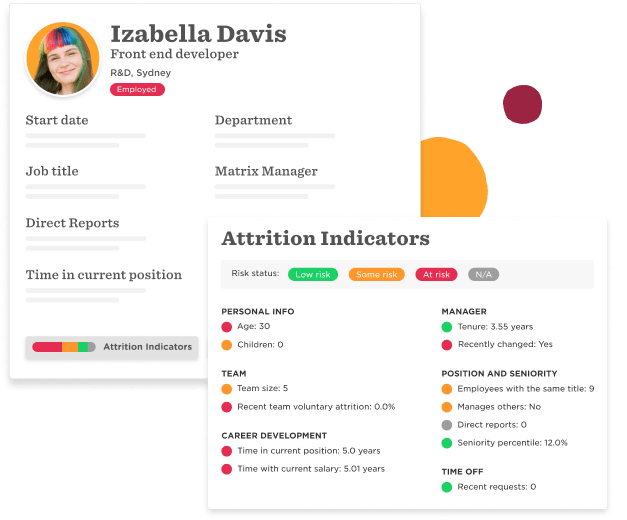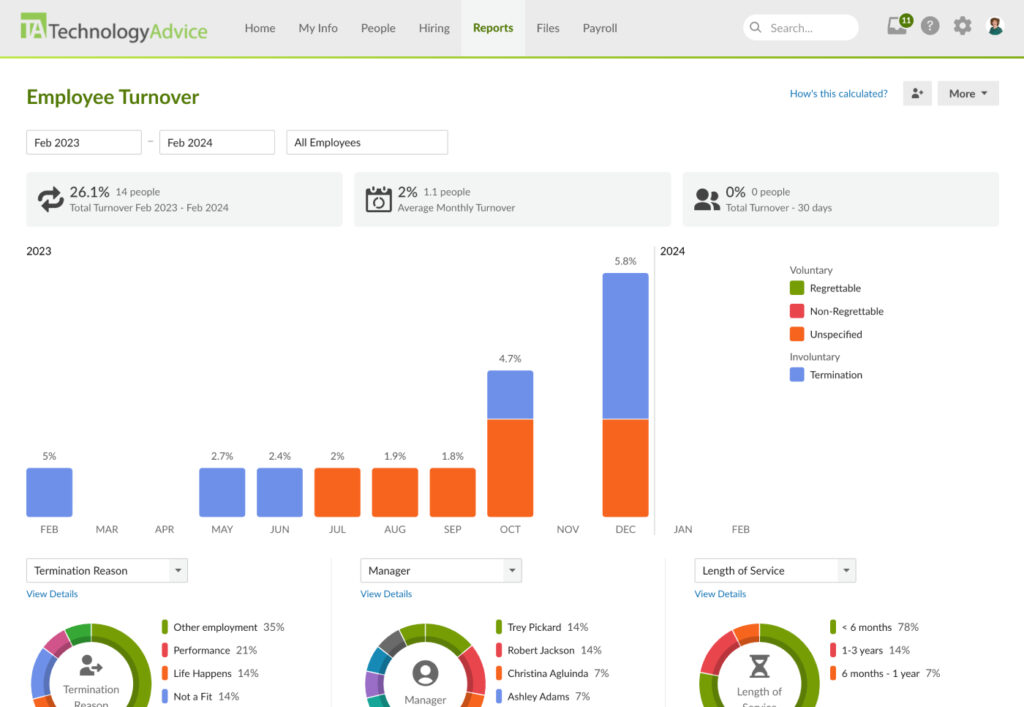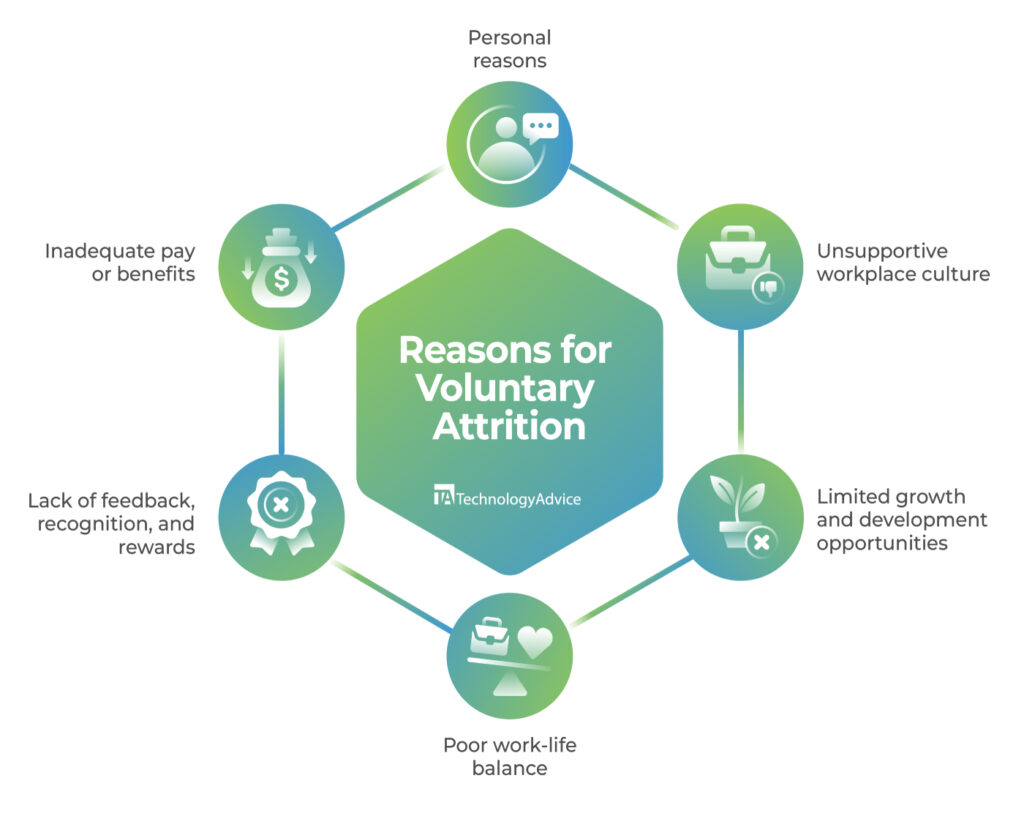Key takeaways
What is attrition rate?
Attrition rate measures how many employees leave a company over a period of time. It gives a glimpse into your company’s overall health, such as the strength of your hiring and retention efforts. It also aids in strategic human resources (HR) processes, such as workplace planning, succession planning, labor cost management, employee engagement, and recruitment.
Attrition rate calculator
Attrition rate and HR metrics
Attrition rate is one of several critical metrics your HR department should track over time. Learn more about various people processes and data to track in our HR metrics series:
How do you calculate attrition rate?
You can calculate your attrition and turnover rates by dividing the total number of employee departures by your average employee headcount and multiplying that by 100. Make sure both numbers encompass the same timeframe. Your answer will be a percentage.
For the more nuanced version of attrition, only consider the number of employees who left and were not replaced before dividing that by your average headcount.
Attrition rate =
Number of employees who left and weren’t replaced in a timeframe
Average number of employees in the same timeframe
x 100
Adjusting the formula allows you to examine attrition from various angles. For example, you can determine your annual attrition rate by examining employee departures over a 12-month timeframe.
Alternatively, you can modify where you pull your employee headcount numbers to glimpse early attrition following a company initiative. For example, you can monitor the attrition rate of a new employee cohort by focusing only on the new hires you hired versus how many left after a certain time.
Types of attrition
There are four types of attrition: voluntary, involuntary, internal, and demographic-specific. These categorizations give a more granular look into the causes of attrition, allowing you to craft targeted approaches to improve the company culture and workplace.
Voluntary
Voluntary attrition is the result of employee-initiated separation due to:
- Resignation.
- Retirement.
- Relocation.
- Personal reasons.
Voluntary attrition is one of the most important categories to monitor since it can indicate more serious problems within your company. For example, high voluntary attrition rates could point to issues like:
- Negative company culture.
- Lack of career development or advancement opportunities.
- Unsafe work environment or practices.
- Unclear work expectations.
- Poor compensation and benefits.
Read more: The 7 Warning Signs of an Unhappy Employee
Conducting exit interviews when employees leave is one way to gain insight into the reasons behind voluntary attrition and build plans to address it. HR systems can also help you develop a proactive strategy. Bob, for instance, uses predictive analytics to pinpoint employees at risk for attrition so you can take steps to retain them.

Involuntary
Involuntary attrition is attrition from employer-initiated separation, including:
- Discharges.
- Layoffs.
- Eliminated positions.
Outside of dismissals for cause, involuntary attrition can result from changes to your business, industry, or market that lead to downsizing or cost-cutting measures.
Internal
Internal attrition occurs when you don’t backfill a position following promotions, demotions, and role or departmental changes. High internal employee attrition is a concern if it causes inequitable work distribution or production bottlenecks from a lack of talent in the roles employees left.
Demographic-specific
Demographic-specific attrition occurs when employees from a particular group leave your organization. Gender-based attrition, for example, looks at attrition based on gender groups. If your attrition rate is higher for folks who identify as female or non-binary, that could indicate a problem with diversity, equity, and inclusion (DEI) in your company.
You can track similar rates for other employee demographics, like race, age, ethnicity, geography, or employment information, to understand how your business practices affect various groups. Layering your attrition data with performance data can also provide a look into attrition causes.
HR software simplifies this process by combining employee demographic information with your separation data for more granular insights. BambooHR, for example, has a separation dashboard that looks at departments and managers that experience the most employee departures for more targeted corrective actions.

What are the causes of attrition?

There are several causes of attrition, many of which are natural and not necessarily negative. For example, employee retirement and relocation are examples of attrition beyond your control.
Attrition due to layoffs or company restructuring could also be natural as companies learn to be more productive with fewer staff. One example is using machine automation to handle repetitive tasks previously managed by a human being.
However, you should still examine the voluntary reasons for employee departures, especially if high voluntary attrition is affecting your company’s success. The table below highlights some of the most common reasons for voluntary attrition and possible solutions.
| Attrition cause | Solution(s) |
|---|---|
| Inadequate pay or benefits | Compare your total rewards package against industry benchmarks to ensure you remain competitive. |
| Limited growth and development opportunities | Create role bands and training courses to support employee development; consider investing in a learning management system (LMS) to facilitate training. |
| Lack of feedback, recognition, and rewards | Require frequent one-on-one meetings between managers and direct reports; provide a platform to support spontaneous peer-to-peer recognition; implement a reward program. |
| Poor work-life balance | Train managers on equitable work distribution; provide clear work start and stop times; offer benefits like flexible schedules and wellness programs. |
| Unsupportive workplace culture | Conduct frequent workplace surveys and develop action plans to address the feedback, such as implementing DEI committees or employee resource groups (ERGs). |
| Personal reasons | Wish the employee the best — employees leaving due to external factors unrelated to work are often beyond your control. |
Attrition vs. turnover
Many companies use the terms attrition and turnover interchangeably. Although both concepts and formulas are essentially the same, two factors distinguish them: time and replacement.
Attrition rate is a more strategic metric since it looks at whether employees are replaced after departing over longer periods. It helps track structural issues within your organization, such as the impact wide-scale company changes have on employee separation. Another way to think of attrition rate is your erosion rate.
By comparison, turnover rate measures employees who leave within a short time. It’s also possible to have a high turnover rate but a low attrition rate. For example, retail and fast food industries can have high turnover rates but stable attrition rates because positions are immediately filled after the employee leaves. Another term for turnover rate is churn rate.
| Attrition rate | Turnover rate | |
|---|---|---|
| Definition | Rate at which employees exit and are not replaced. | Rate at which employees leave and are replaced. |
| Impact | Long-term concept for strategic workforce planning. | Short-term concept for monitoring minimum staffing levels. |
| Also known as | “Erosion rate” | “Churn rate” |
Attrition vs. retention
Attrition and retention are two sides of the same coin. Attrition monitors the number of employees who leave, while retention looks at the number who stay over a set period.
Attrition and retention usually reflect the same data in different ways. For example, if you have a high attrition rate from many people leaving, you might have a proportionally low employee retention rate.
The intent of each data point is also different. For example, your executive team might be interested in your attrition rate to understand your company’s readiness for growth. However, your HR teams might be more interested in retention rates as a reflection of your people strategy and how they can improve the employee experience.
| Attrition | Retention | |
|---|---|---|
| Definition | Employees exit and are not replaced, resulting in a smaller headcount over time. | Employees stay with the organization instead of seeking employment elsewhere. |
| Focus | Workforce planning and company structuring. | Employee satisfaction and development. |






